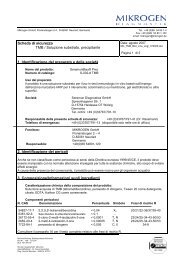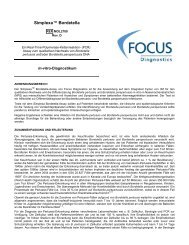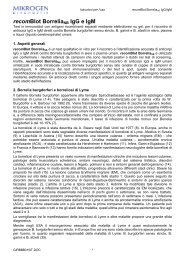recomLine EBV IgG [Avidity] [IgA] recomLine EBV IgM ... - Mikrogen
recomLine EBV IgG [Avidity] [IgA] recomLine EBV IgM ... - Mikrogen
recomLine EBV IgG [Avidity] [IgA] recomLine EBV IgM ... - Mikrogen
You also want an ePaper? Increase the reach of your titles
YUMPU automatically turns print PDFs into web optimized ePapers that Google loves.
Epstein-Barr Virus<br />
New Antigens<br />
ZEBRA, BZLF1<br />
<strong>recomLine</strong> <strong>EBV</strong> <strong>IgG</strong> [<strong>Avidity</strong>] [<strong>IgA</strong>]<br />
<strong>recomLine</strong> <strong>EBV</strong> <strong>IgM</strong><br />
Strip-Immunoassay with antigens produced by recombinant techniques for the detection of <strong>IgG</strong>, <strong>IgA</strong> and <strong>IgM</strong> antibodies<br />
against the Epstein-Barr virus (<strong>EBV</strong>)<br />
The Epstein-Barr virus, an ubiquitously occurring herpes virus, can cause the<br />
symptoms of infectious mononucleosis (Pfeiffer´s disease) on primary infection.<br />
Moreover, as a result of the lifelong persistence of this pathogen, reactivations<br />
can occur, especially in immuno-incompetent persons.<br />
Due to the diversity of symptoms caused by primary infection or reactivation<br />
and their correspondence with the symptoms of other diseases, one of the<br />
main tasks in routine diagnosis is the serological detection of a primary infection,<br />
past infection or possible reactivation. For this purpose, a series of individual<br />
determinations (EIA and IFT) are generally carried out for the particular<br />
class of antigen and type of antibody.<br />
The <strong>recomLine</strong> <strong>EBV</strong>, with the antigens sprayed onto the nitrocellulose, is designed<br />
as screening immunoassay. The line-assay technique allows the detection<br />
and identification of <strong>IgG</strong> and <strong>IgM</strong> antibodies directed against the different<br />
<strong>EBV</strong> antigen classes in a single approach. The application of highly specific and<br />
characteristic <strong>EBV</strong> proteins is made possible by the use of antigens produced by<br />
genetic engineering.<br />
Product Advantages<br />
•<br />
•<br />
•<br />
•<br />
•<br />
•<br />
•<br />
„The combination of p18 and EBNA-1 (in <strong>IgG</strong> detection) represents a so far unrivalled<br />
degree of certainty in the exclusion of primary infections ...“<br />
Recombinant antigens<br />
�<br />
�<br />
�<br />
�<br />
�<br />
�<br />
High sensitivity and specificity<br />
Easy and clear interpretation due to easy to read bands<br />
No interference with anticellular antibodies<br />
Patent protected p18 <strong>Mikrogen</strong> as additional <strong>IgG</strong> marker for past infections<br />
New antigens: Maximum sensitivity by BZLF1 in <strong>IgG</strong> and ZEBRA in <strong>IgM</strong> detection<br />
Easy and reliable determination of avidity - patent protected<br />
Safe evaluation due to strip specific controls (cut-off and conjugate control)<br />
Easy test procedure; automation possible<br />
Easy and objective evaluation and documentation by recomScan software<br />
Test procedure and reagents identical in all MIKROGEN strip tests - reagents exchangeable<br />
CE label: The <strong>recomLine</strong> <strong>EBV</strong> tests meet the high standard of the EC directive 98/79/EC on in vitro<br />
diagnostic medical devices<br />
More than 95 % of the past <strong>EBV</strong> infections are correctly identified with the <strong>recomLine</strong> <strong>EBV</strong> <strong>IgG</strong> strip only<br />
Recombinant <strong>EBV</strong> Antigens used in the Test<br />
Prof. Dr. G. Bauer, Freiburg ‘99<br />
<strong>EBV</strong> Antigen Groups Abbreviation Recombinant Antigen Size of rec. Antigens<br />
Nuclear Antigen EBNA-1 p72 45 kDal<br />
Virus capsid/structural antigens VCA<br />
„Immediate Early Antigen“ IEA<br />
„Early antigens“ EA<br />
p23<br />
p18<br />
ZEBRA (Peptid)<br />
BZLF1<br />
p54<br />
p138<br />
React. contr.<br />
Conjugate contr.<br />
<strong>IgG</strong><br />
<strong>IgA</strong><br />
<strong>IgM</strong><br />
Cut-off contr.<br />
EBNA-1<br />
p18<br />
p23<br />
ZEBRA<br />
BZLF1<br />
p138<br />
p54<br />
<strong>IgG</strong><br />
<strong>IgA</strong><br />
23 kDal<br />
18 kDal<br />
1,6 kDal<br />
30 kDal<br />
54 kDal<br />
40 kDal<br />
<strong>IgM</strong>
Test Principle and Procedure<br />
Typical course of an <strong>EBV</strong> infection<br />
1. Sample<br />
2. Sample<br />
1 Week<br />
3. Sample<br />
2 Weeks<br />
4. Sample<br />
4 Weeks<br />
5. Sample<br />
8 Weeks<br />
6. Sample<br />
14 Weeks<br />
7. Sample<br />
11 Months<br />
E E E<br />
<strong>IgG</strong><br />
Avid.<br />
<strong>IgM</strong><br />
<strong>IgG</strong><br />
Avid.<br />
<strong>IgM</strong><br />
<strong>IgG</strong><br />
Avid.<br />
<strong>IgM</strong><br />
<strong>IgG</strong><br />
Avid.<br />
<strong>IgM</strong><br />
<strong>IgG</strong><br />
Avid.<br />
<strong>IgM</strong><br />
<strong>IgG</strong><br />
Avid.<br />
<strong>IgM</strong><br />
<strong>IgG</strong><br />
Avid.<br />
<strong>IgM</strong><br />
Cutoff<br />
EBNA-1<br />
p18<br />
p23<br />
ZEBRA<br />
BZLF1<br />
p138<br />
p54<br />
+ - - - +++ + ++<br />
+ - ++ +/- +++<br />
+ - - ++ +++ ++ ++<br />
+ - - ++ +++ ++ ++<br />
+ - - ++ ++ ++ ++<br />
+ - + - ++<br />
+ - + ++ ++ ++ ++<br />
+ - + - ++<br />
+ - ++ ++ ++ ++ +<br />
+ - - - +<br />
+ + ++ ++ + + -<br />
+ - - - -<br />
Article-No Storage and Shelf Life<br />
4572 <strong>recomLine</strong> <strong>EBV</strong> <strong>IgG</strong> [<strong>Avidity</strong>]* [<strong>IgA</strong>]*<br />
Reagents for 20 determinations<br />
4573 <strong>recomLine</strong> <strong>EBV</strong> <strong>IgM</strong><br />
Reagents for 20 determinations<br />
10076 Line - anti-Human <strong>IgA</strong> conjugate, 500 µl<br />
11010 Blot, Line - avidity reagent<br />
Reagent for 25 avidity determinations<br />
1 st Incubation A test strip loaded with <strong>EBV</strong> antigens is incubated with<br />
diluted serum or plasma in a dish for 1 hour.<br />
+ - ++ +/- +++<br />
+ - + - +++<br />
positive<br />
p23 interm.<br />
positive<br />
positive<br />
p23 high<br />
p18 low<br />
positive<br />
positive<br />
p23 high<br />
p18 low<br />
positive<br />
positive<br />
p23 high<br />
p18 high<br />
negative<br />
*[] optional available as additional reagent<br />
wash 3 times<br />
2 nd Incubation Peroxidase conjugated anti-human antibodies (<strong>IgG</strong>, <strong>IgA</strong><br />
or <strong>IgM</strong> specific) are added. Incubate for 45 minutes.<br />
wash 3 times<br />
Color reaction 5 - 10 minutes after addition of the coloring solution,<br />
insoluble colored bands develop at the sites on the test<br />
strips occupied by antibodies.<br />
positive<br />
---<br />
positive<br />
positive<br />
p23 low<br />
positive<br />
positive<br />
p23 interm.<br />
positive<br />
acute<br />
infection<br />
acute<br />
infection<br />
acute<br />
infection<br />
acute<br />
infection<br />
recent<br />
infection<br />
recent<br />
infection<br />
past<br />
infection<br />
BZLF1 <strong>IgG</strong> and ZEBRA <strong>IgM</strong> appear<br />
as early markers beside the EA antigens<br />
(<strong>IgG</strong> and <strong>IgM</strong>)<br />
p18 <strong>IgG</strong> appears as late marker in<br />
the 8th week (sample 5)<br />
<strong>Avidity</strong> of p23 <strong>IgG</strong> rises during<br />
approx. 7 weeks (sample 2-5)<br />
EBNA-1 <strong>IgG</strong> appears as late marker<br />
after 11 months (sample 7)<br />
At +2°C - +8°C<br />
18 months from the date of production<br />
MIKROGEN GmbH | Floriansbogen 2-4 | 82061 Neuried | Germany | Tel.: +49 89 54801-0 | Fax: +49 89 54801-100<br />
Internet: www.mikrogen.de | eMail: mikrogen@mikrogen.de<br />
•<br />
•<br />
•<br />
•<br />
pirlebe008n


![recomLine EBV IgG [Avidity] [IgA] recomLine EBV IgM ... - Mikrogen](https://img.yumpu.com/6326010/1/500x640/recomline-ebv-igg-avidity-iga-recomline-ebv-igm-mikrogen.jpg)
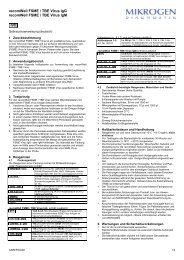

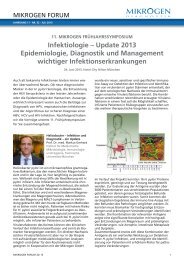

![recomLine EBV IgG [aviditet] [IgA] recomLine EBV IgM - Mikrogen](https://img.yumpu.com/19720026/1/184x260/recomline-ebv-igg-aviditet-iga-recomline-ebv-igm-mikrogen.jpg?quality=85)
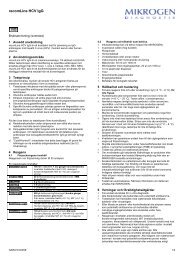
![recomBlot CMV IgG [Avidità] - Mikrogen](https://img.yumpu.com/16294013/1/184x260/recomblot-cmv-igg-avidita-mikrogen.jpg?quality=85)
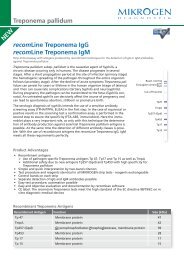
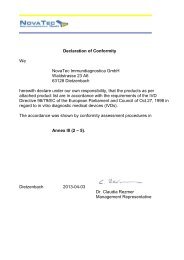
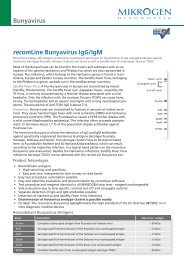
![recomBead Yersinia IgG recomBead Yersinia IgA [IgM] - Mikrogen](https://img.yumpu.com/15461030/1/184x260/recombead-yersinia-igg-recombead-yersinia-iga-igm-mikrogen.jpg?quality=85)
